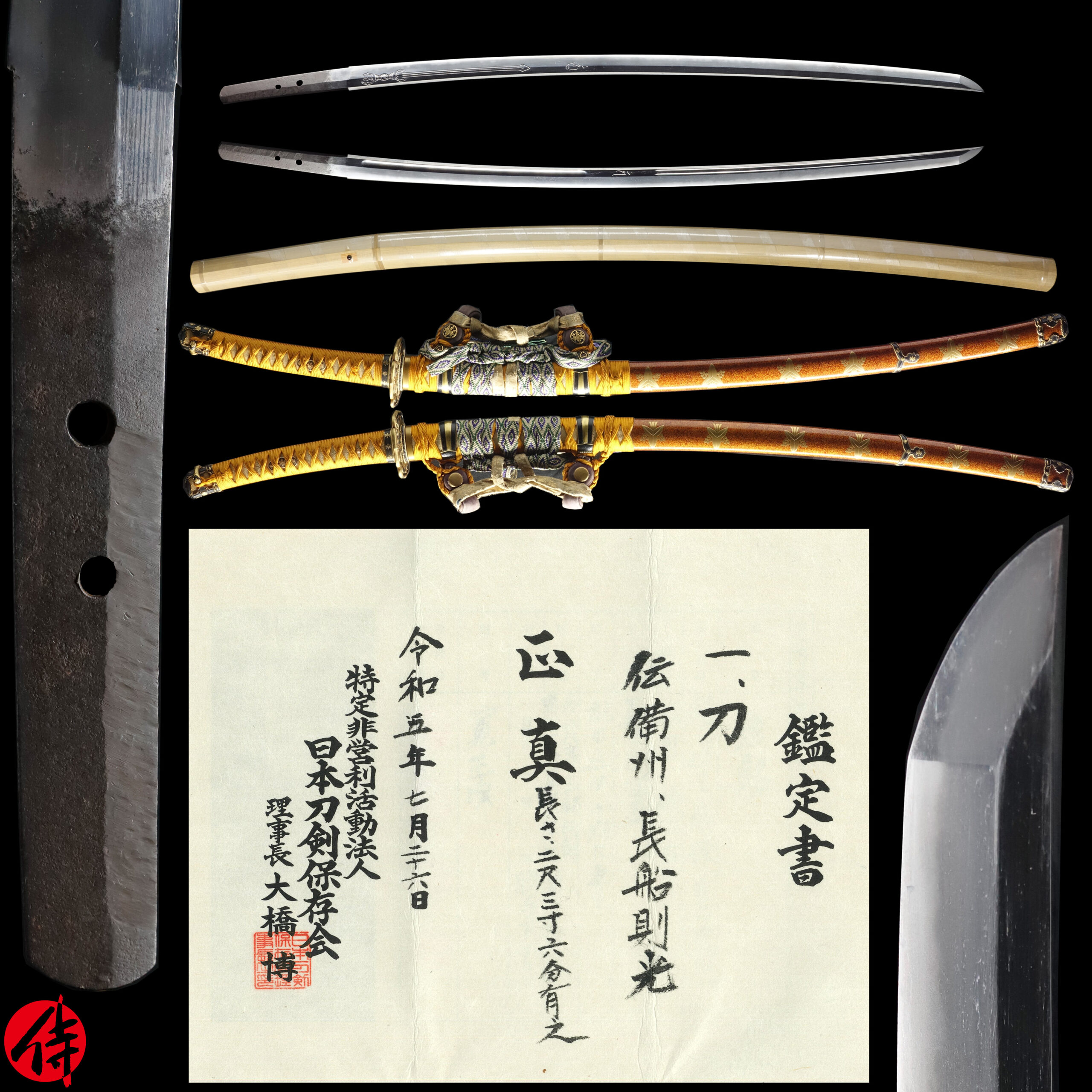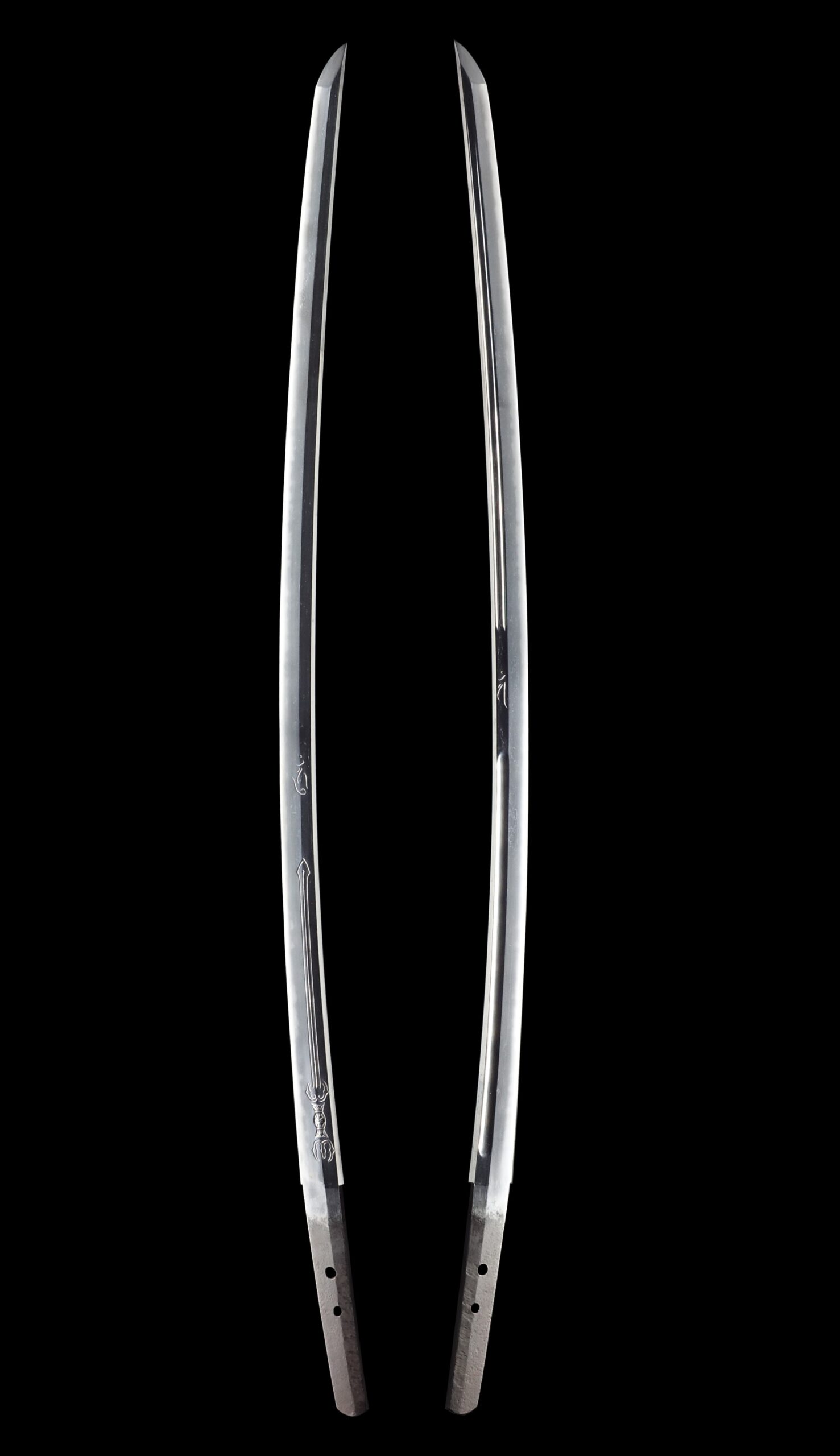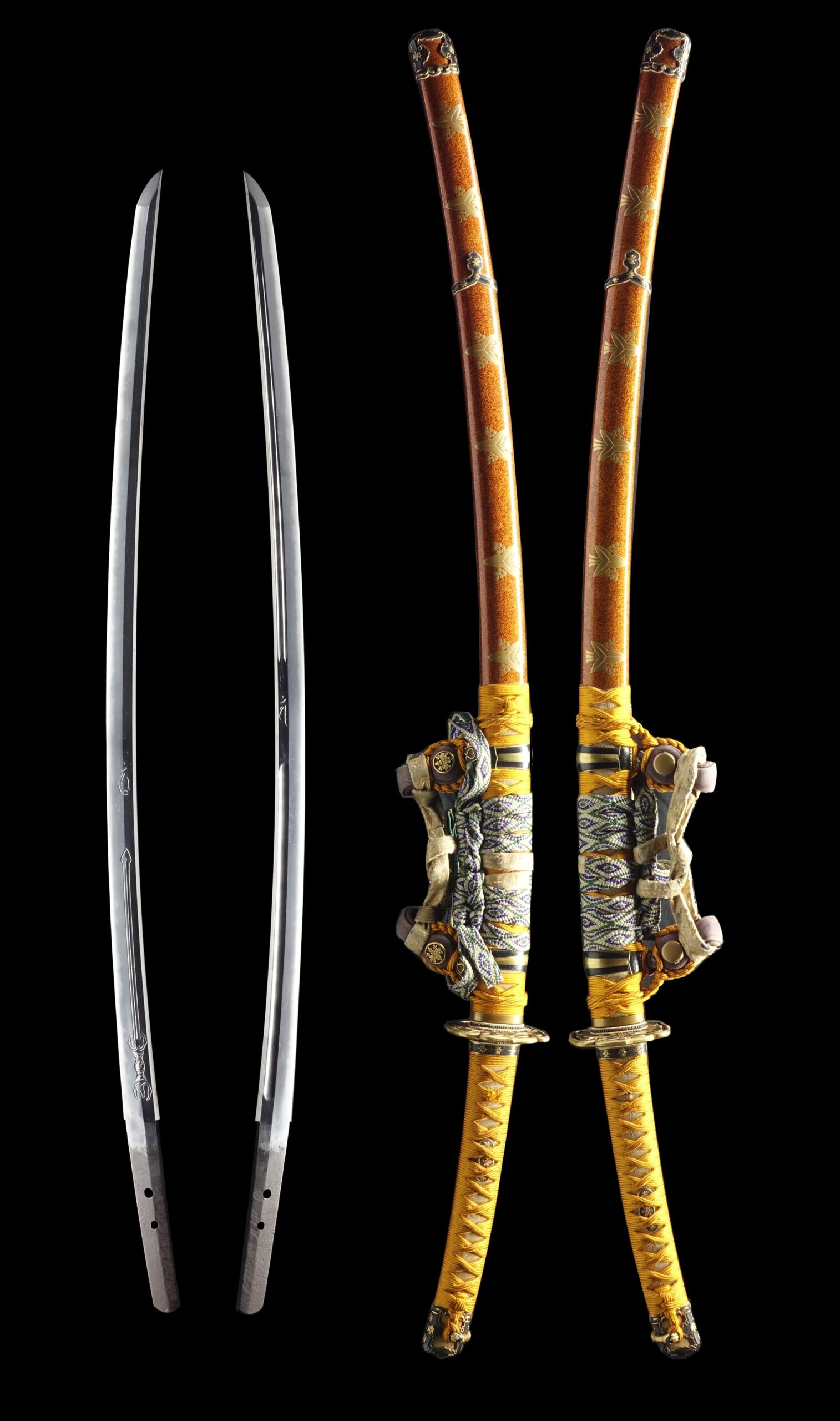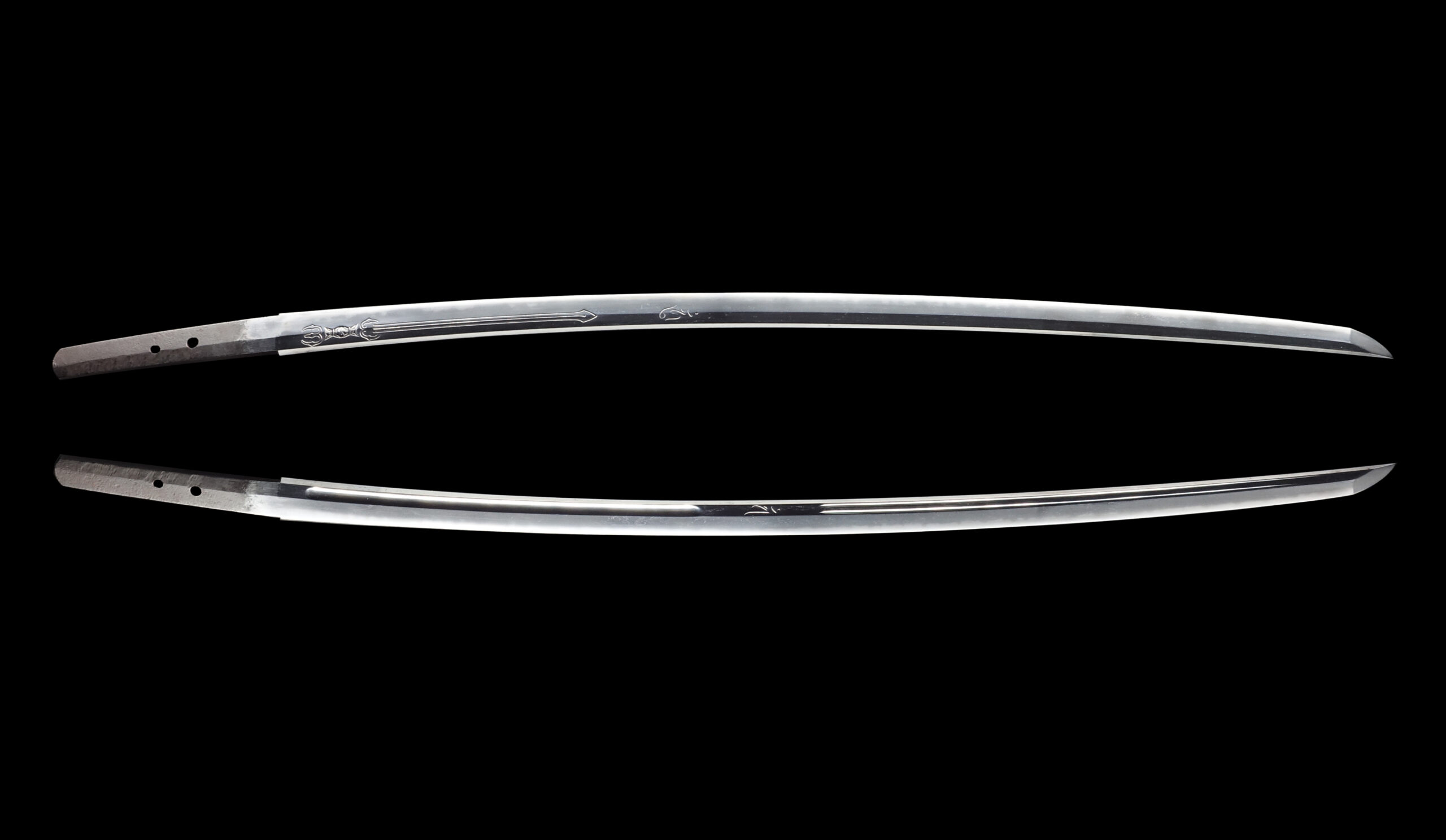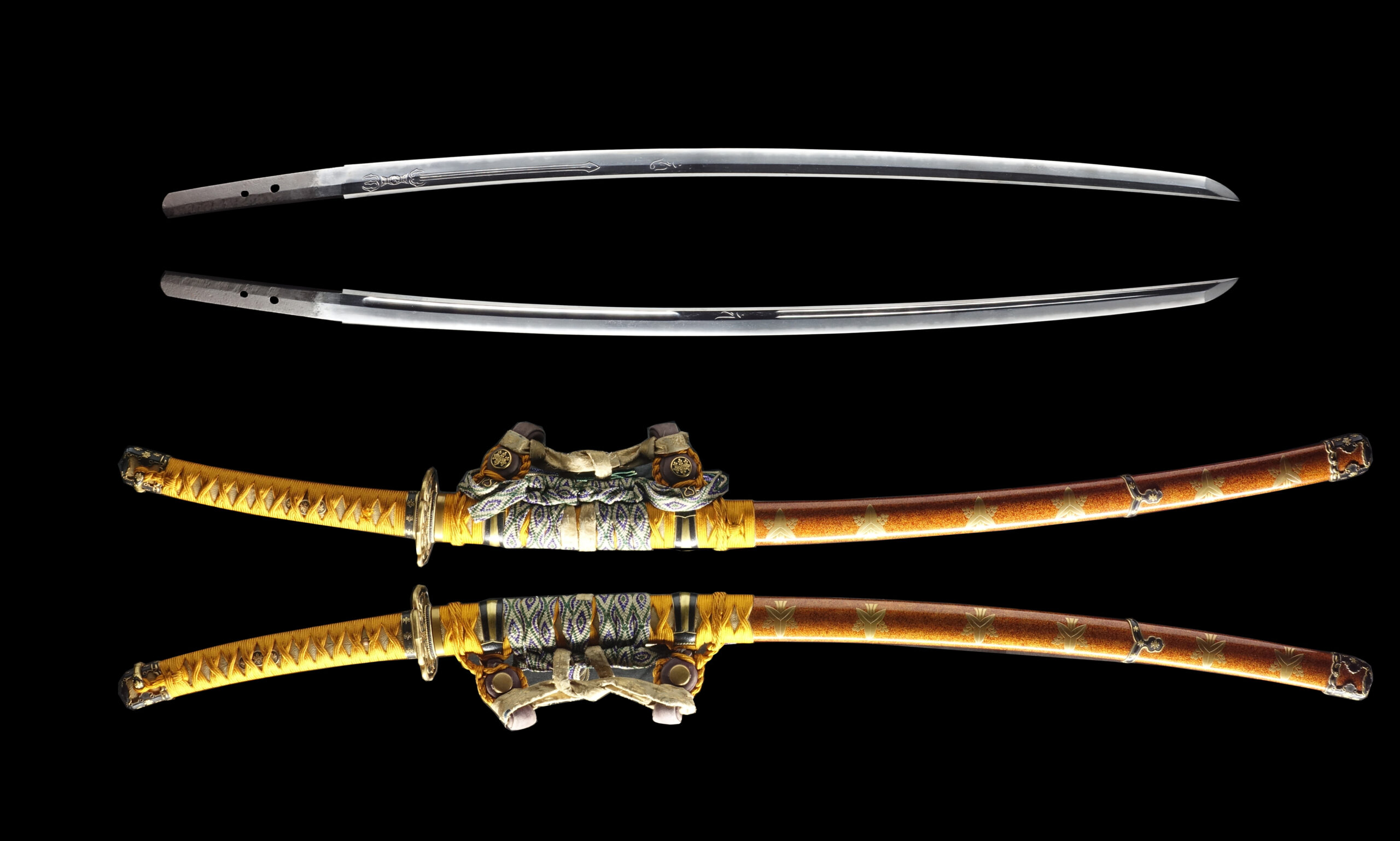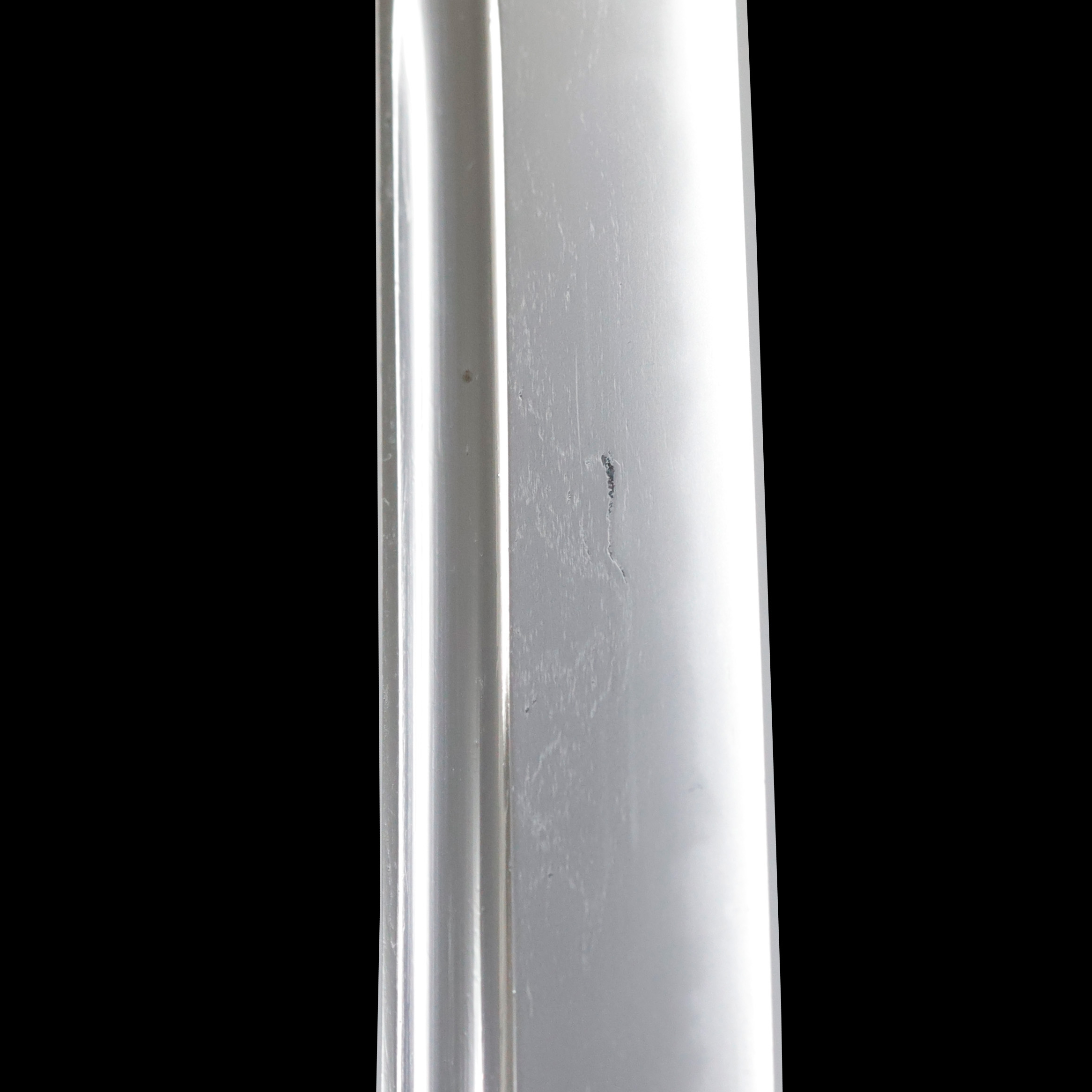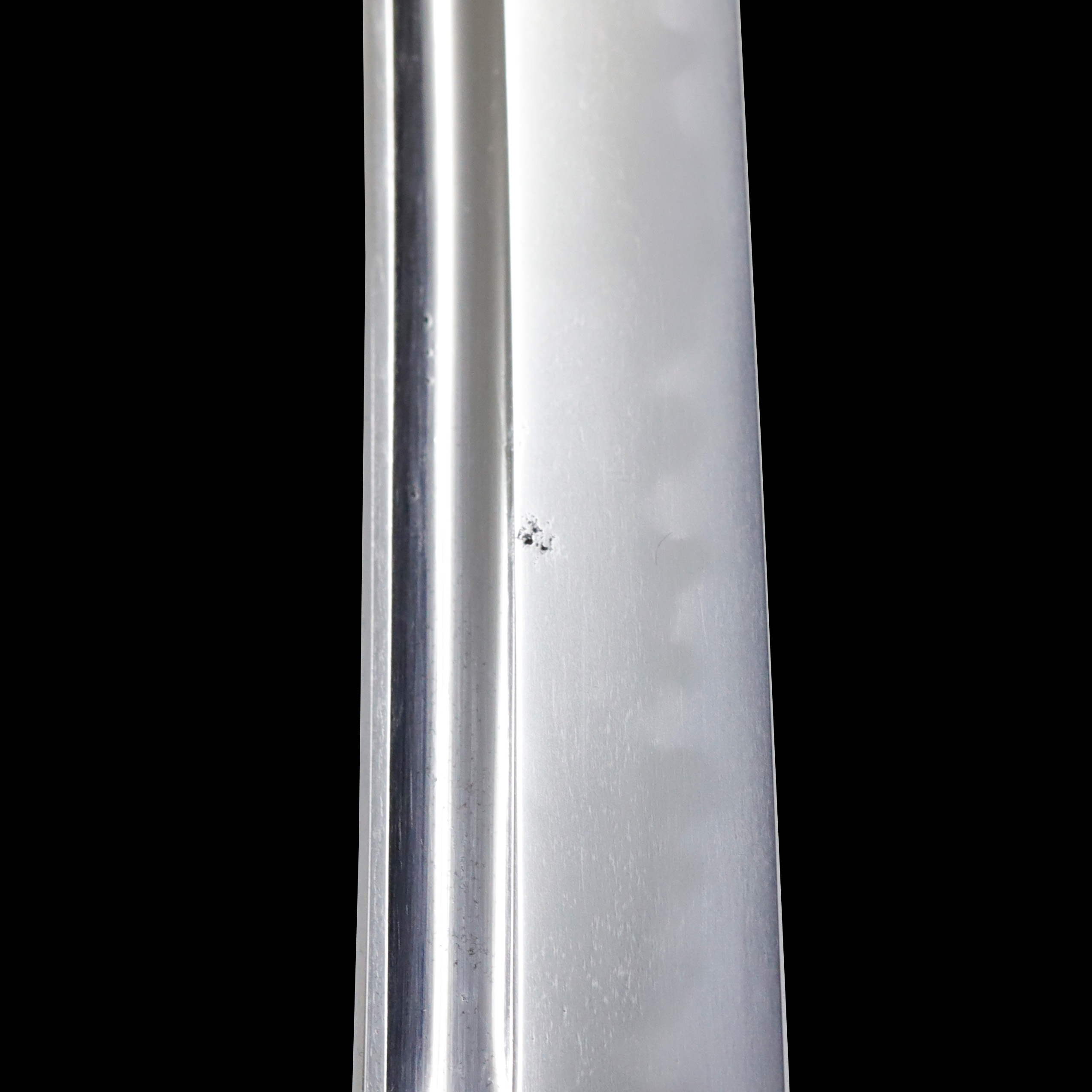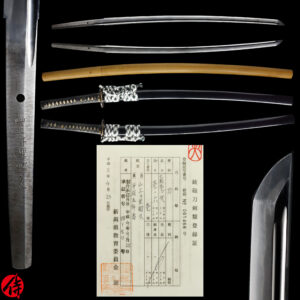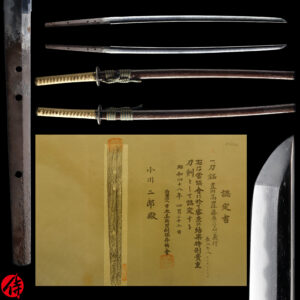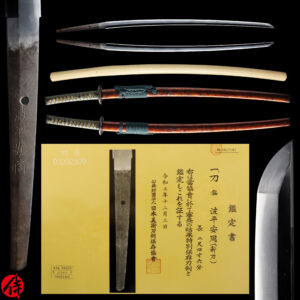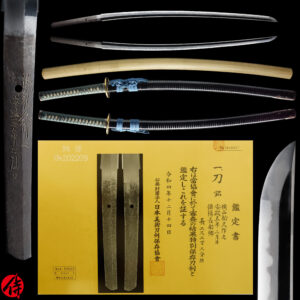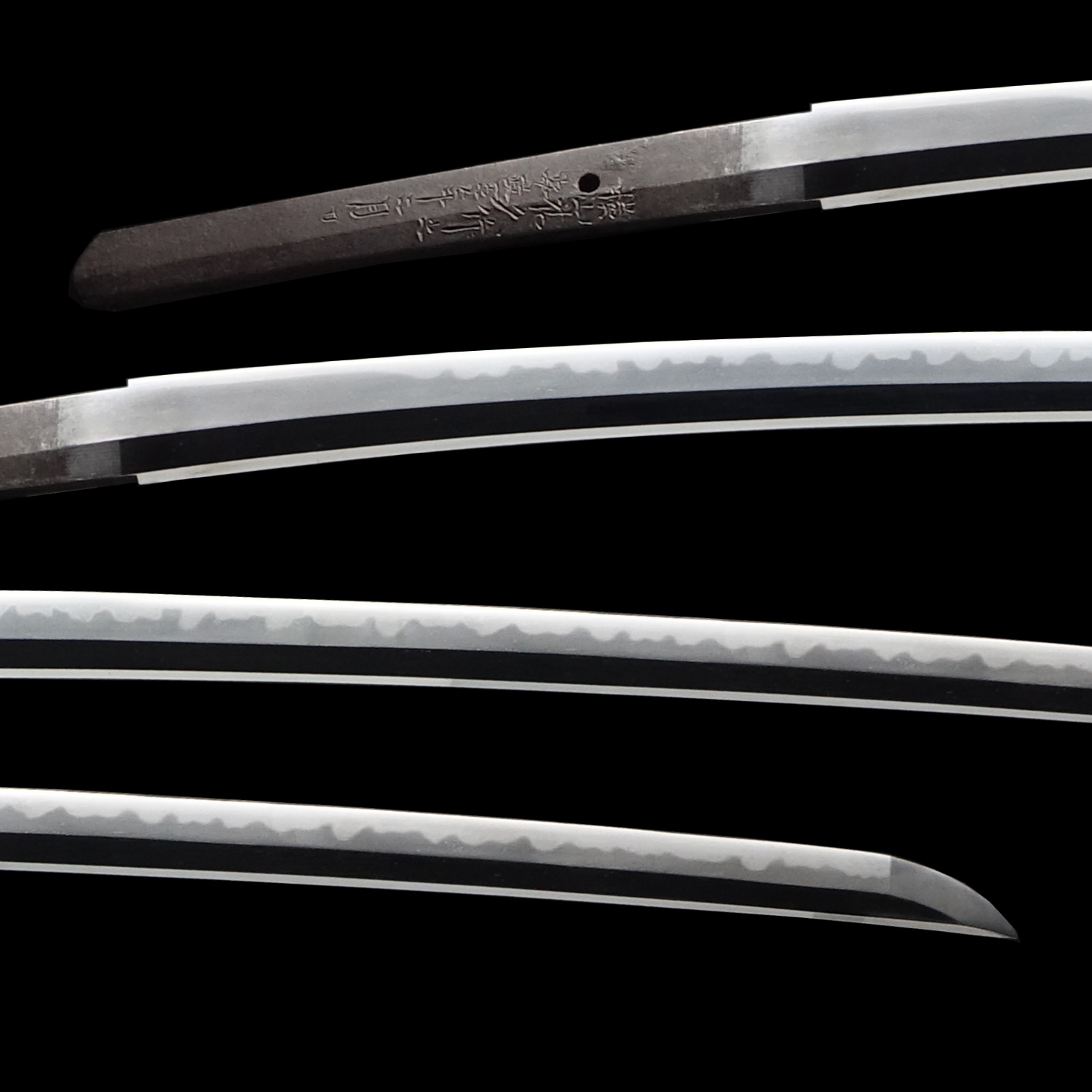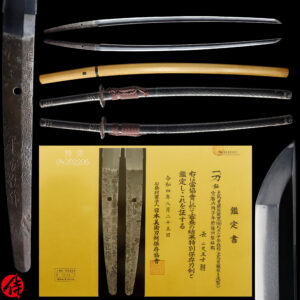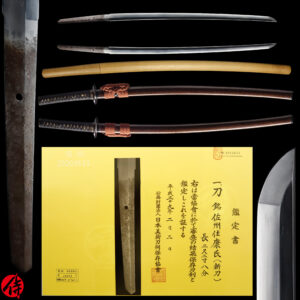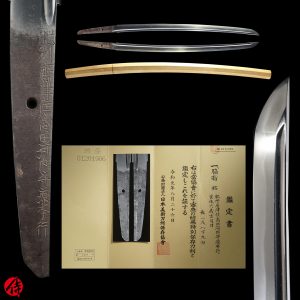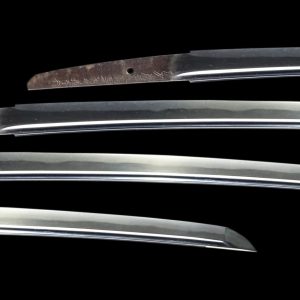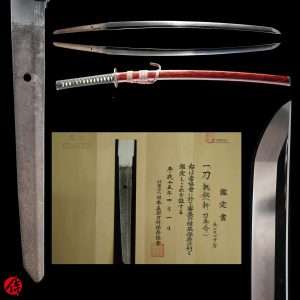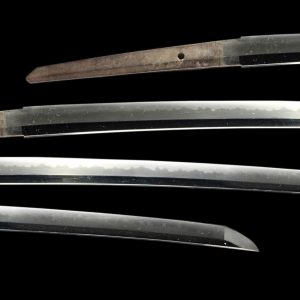Antique Japanese Sword Katana Katana Attributed to Bizen Norimitsu with NTHK Kanteisho for the blade and NBTHK Hozon for the Koshirae
【Description】
Summary
This blade is attributed to Bizen Osafune Norimitsu, active during the Kansho era (1460-1466: Mid Muromachi period), according to its NTHK’s appraisal. Bizen is in today’s Okayama prefecture, and Osafune was the name of the prestigious school in this area. The maker’s name, “Norimitsu,” lasted several generations from the late Kamakura period to the end of the Muromachi period (Early 14th-late 16th century). Based on the appraisal, we believe the attribution was given to the 5th-gen Norimitsu.
The first-gen Norimitsu was an apprentice of Nagamitsu, one of the most famous swordsmiths in Bizen province during the late Kamakura period. And superb level of craftsmanship was passed down to later generations.
The swordsmiths in Bizen produced many swords during the Muromachi period, as it was in the middle of the Sengoku period (Warring State period). The demand for weapons increased among strong feudal lords. It would be nice to have a piece forged in the warring state period when warlords had so much rivalry. It was possible that a Samurai ordered this blade, and he might have carried it on a battlefield.
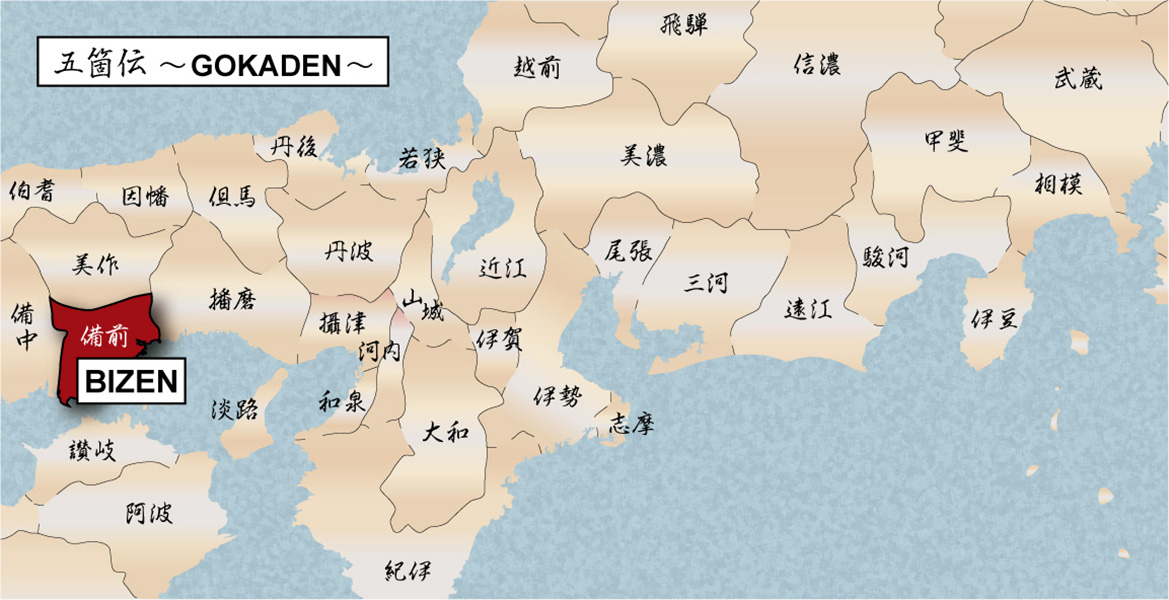
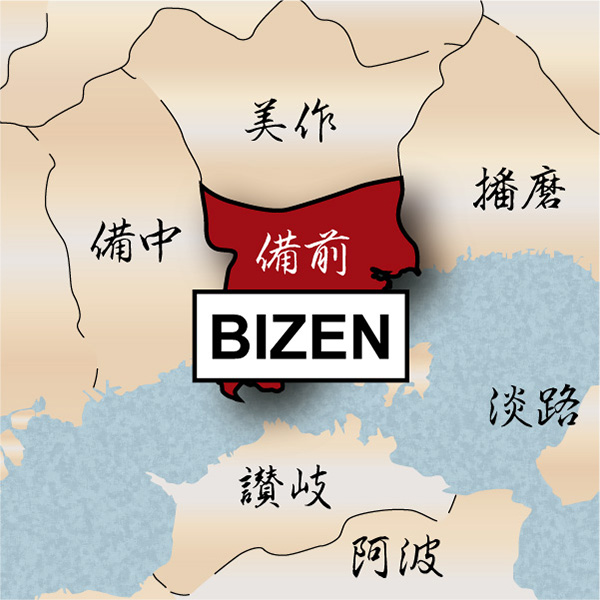
This History of Bizen Osafune School
It is said that Osafune school was founded by Mitsutada (光忠), who was active during the mid-Kamakura period. Bizen Osafune school was the biggest one of all other schools in Bizen province, and they received many orders from feudal lords or renowned Samurai. They were called Osafunemono and were beloved by Samurai warriors.
Among the swordsmiths who belonged to this school, Nagamitsu, Sanenaga, and Kagemitsu are known as Osafune Sansaku, the three renowned Osafune swordsmiths. There are also four other prominent swordsmiths who were from Bizen Osafune school. They are called Osafune Shiten-no, the four masters of Osafune school. Their names are Nagamitsu, Kanemitsu, Nagayoshi, and Motoshige.
BIZEN is located near the Chugoku Mountains, where iron sands, one of the essential materials for making Japanese swords, were abundant. Furthermore, BIZEN swordsmiths had close access to the Yoshi River, where they could find water and charcoal. This geological location contributed to the swordsmiths forging high-quality refined blades. We presume BIZEN was quite active in sword-forging from ancient times. It is said that BIZEN DEN was created by groups of swordsmiths there during the late Heian era (Late 12th century). These ancient swordsmiths in Bizen province are called Ko-Bizen (Old Bizen) swordsmiths. By inheriting the sword forging techniques from Ko-Bizen swordsmiths, the Bizen Osafune school flourished from the mid-Kamakura period.
Horimono (Engraving on the blade)
You can find the engraving of a Tsurugi (Double-edged blade) on one side. This blade is Kurikaraken, which is the sword that Fudo Myo-O (不動明王, acalanātha) holds with his right hand. Fudo Myo-O is one of the objects of worship in Buddhism. According to a theory, it is the incarnation of Dainichi Nyorai (大日如来, Mahāvairocana, the principal image of esoteric Buddhism). Kurikara-ken was named after its appearance that Kurikara Ryu-O (倶利伽羅龍王, dragon) is winding around the sword. It is believed Kurikara-Ken could cut off worldly desires: Sandoku (三毒). Sandoku is the three fundamental human desires; Ton (貪, greed), Jin (瞋, anger, grudge), Chi (癡, delusion, complaint). The other side shows Sanskrit letter, which symbolizes Fudo Myo-O.
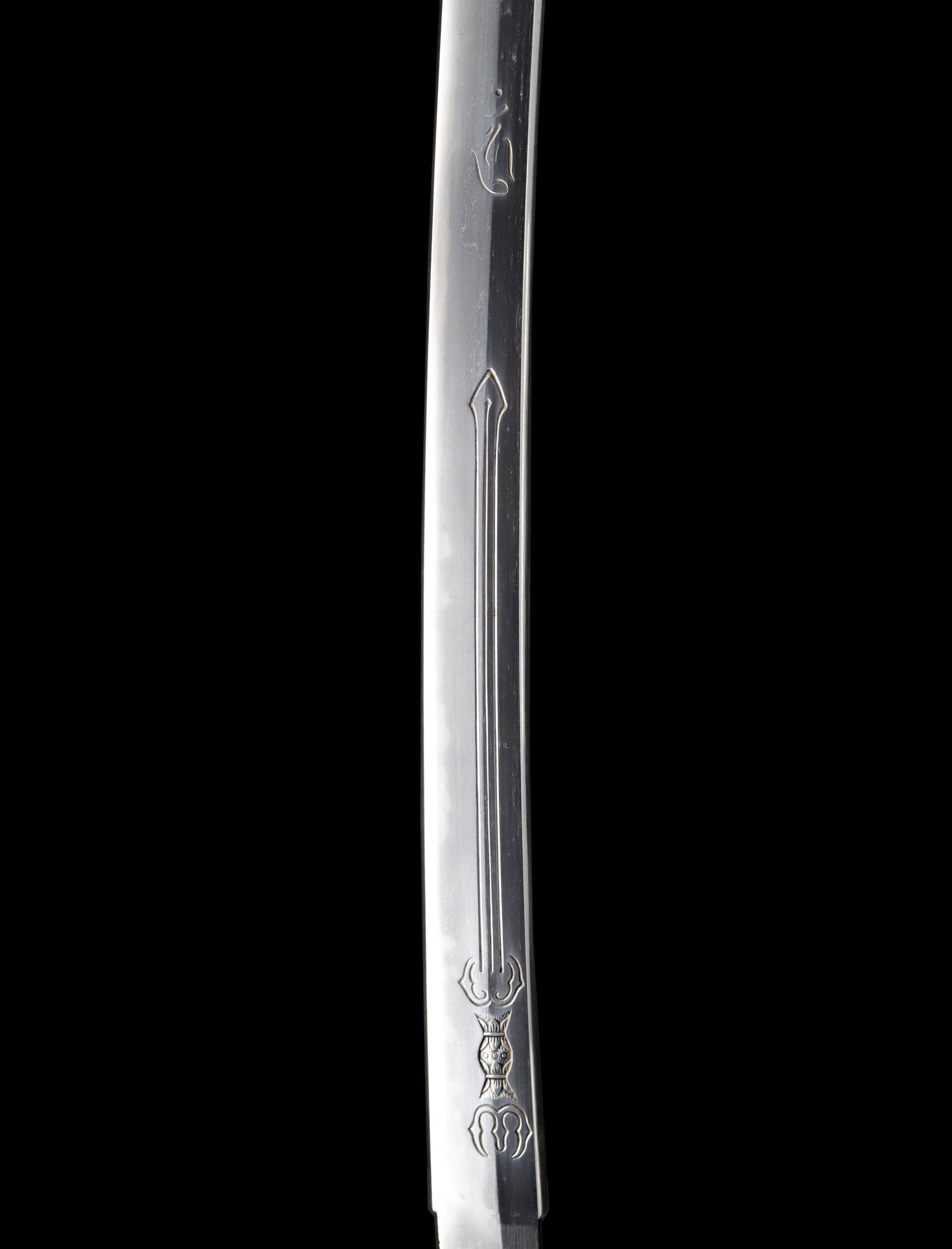

Tachi Koshirae
This blade is stored in Tachi(太刀) Koshirae. Tachi was mainly used by an armored Samurai with one hand on horseback from the Heian period (794-1185 A.D.) until the early Muromachi period. TACHI was suspended loosely on the left waist with its edge facing the ground so that you could draw it faster to cut down soldiers on the ground. Because of its gorgeous looking, having a Tachi-style sword mounting became a social status among Samurai. This Koshirae was appraised as a Hozon Tosogu by NBTHK.
*Please keep in mind that there are a couple of Kitae Kizu on the blade and Mune (backbone of the blade) . If you like to see the detailed condition, please feel free to contact us.
【 Blade】
Cutting Edge Length(Nagasa): 71.6 cm (28.2 inches)
Curvature(Sori):2.0 cm (0.79 inches)

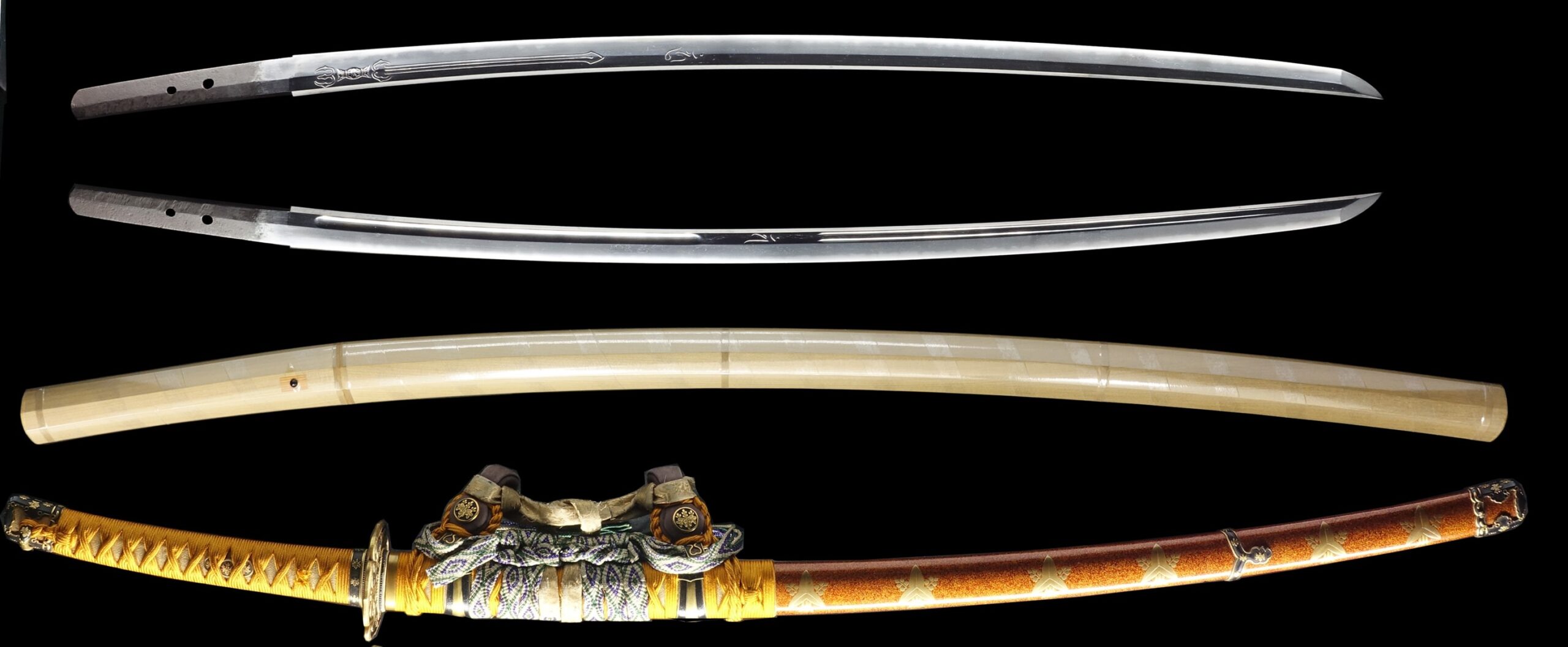
Hamon:
The crystalline structure which forms along the cutting edge of a blade as a result of the hardening process
Jimon(Jihada):
visible steel surface pattern created by folding and hammering during forging process
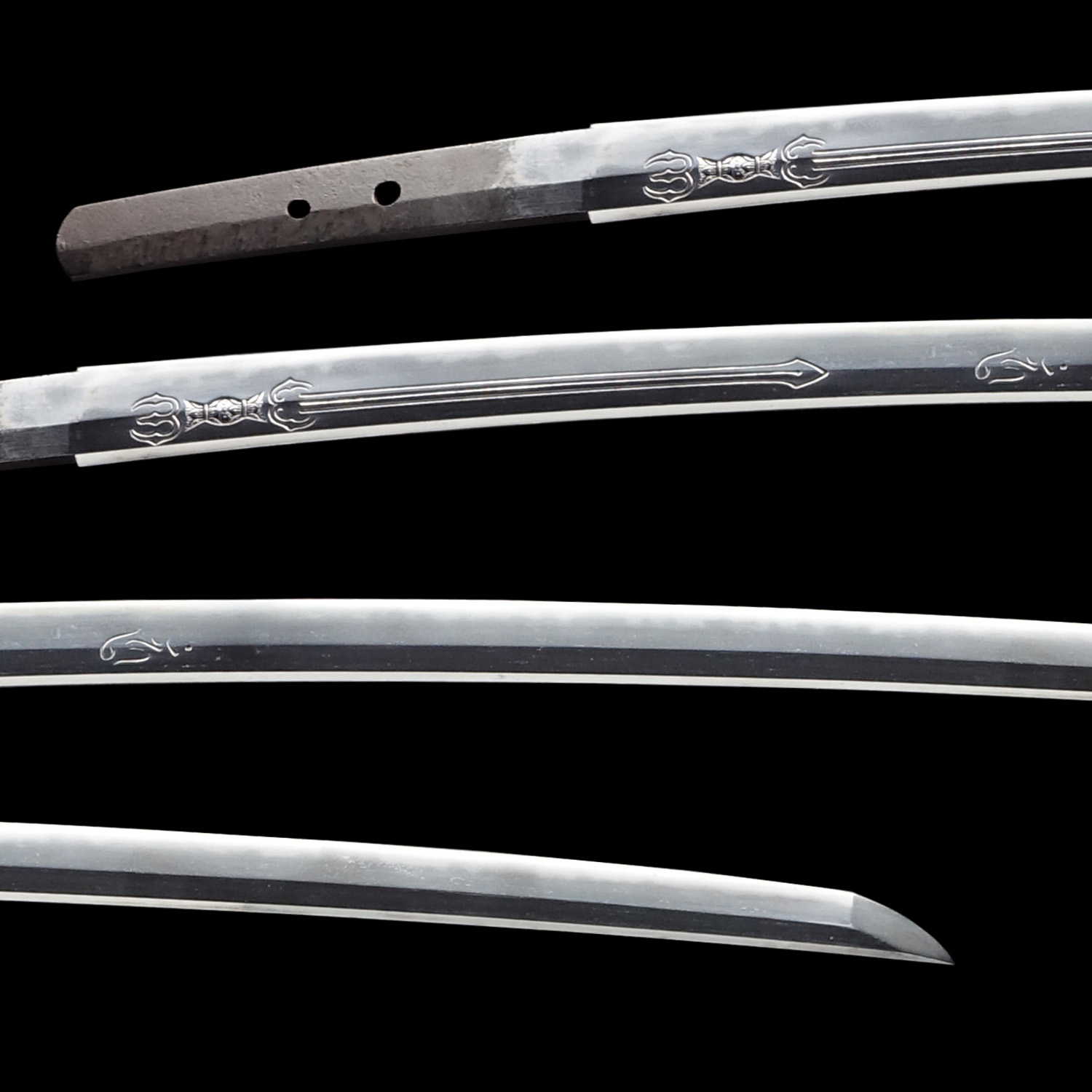
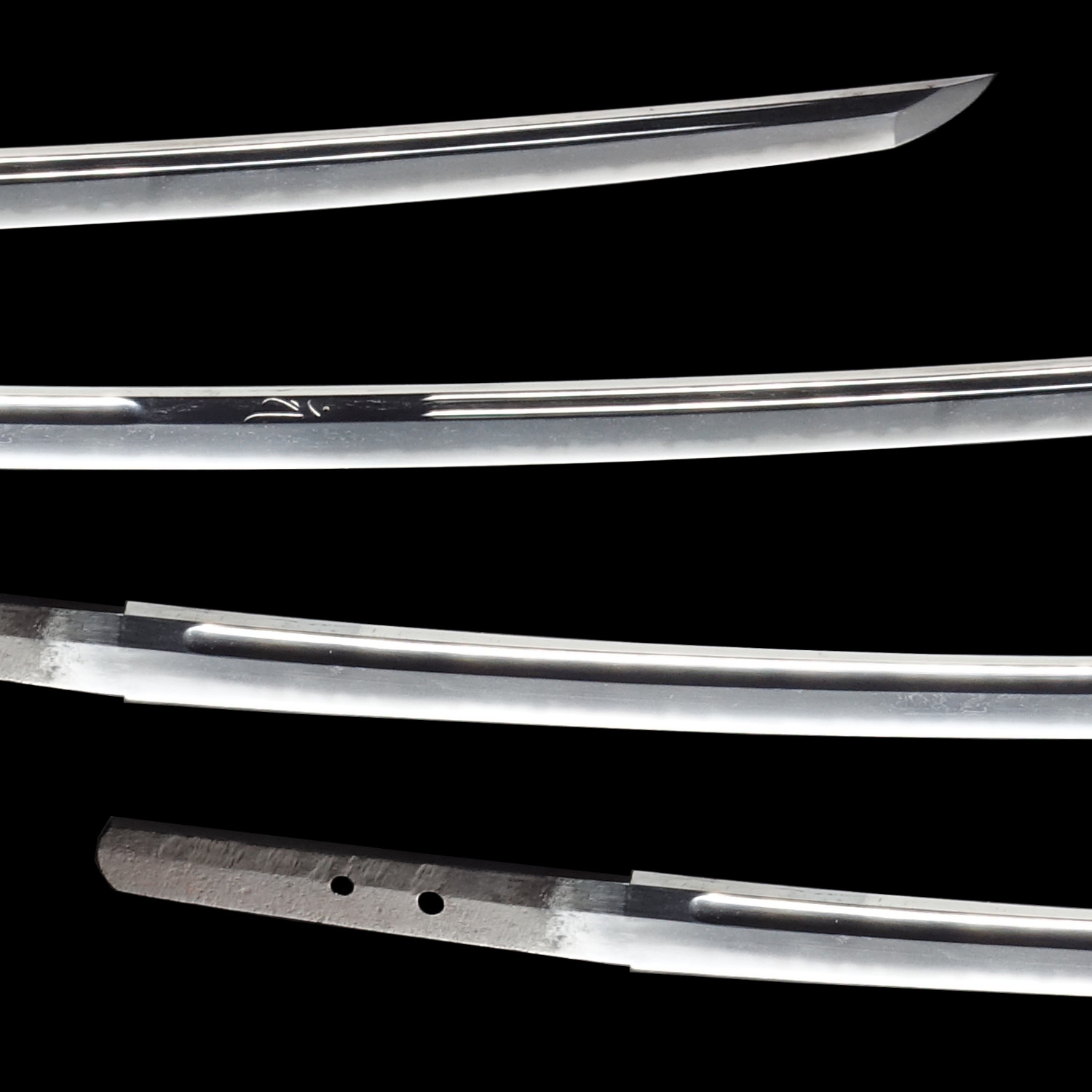



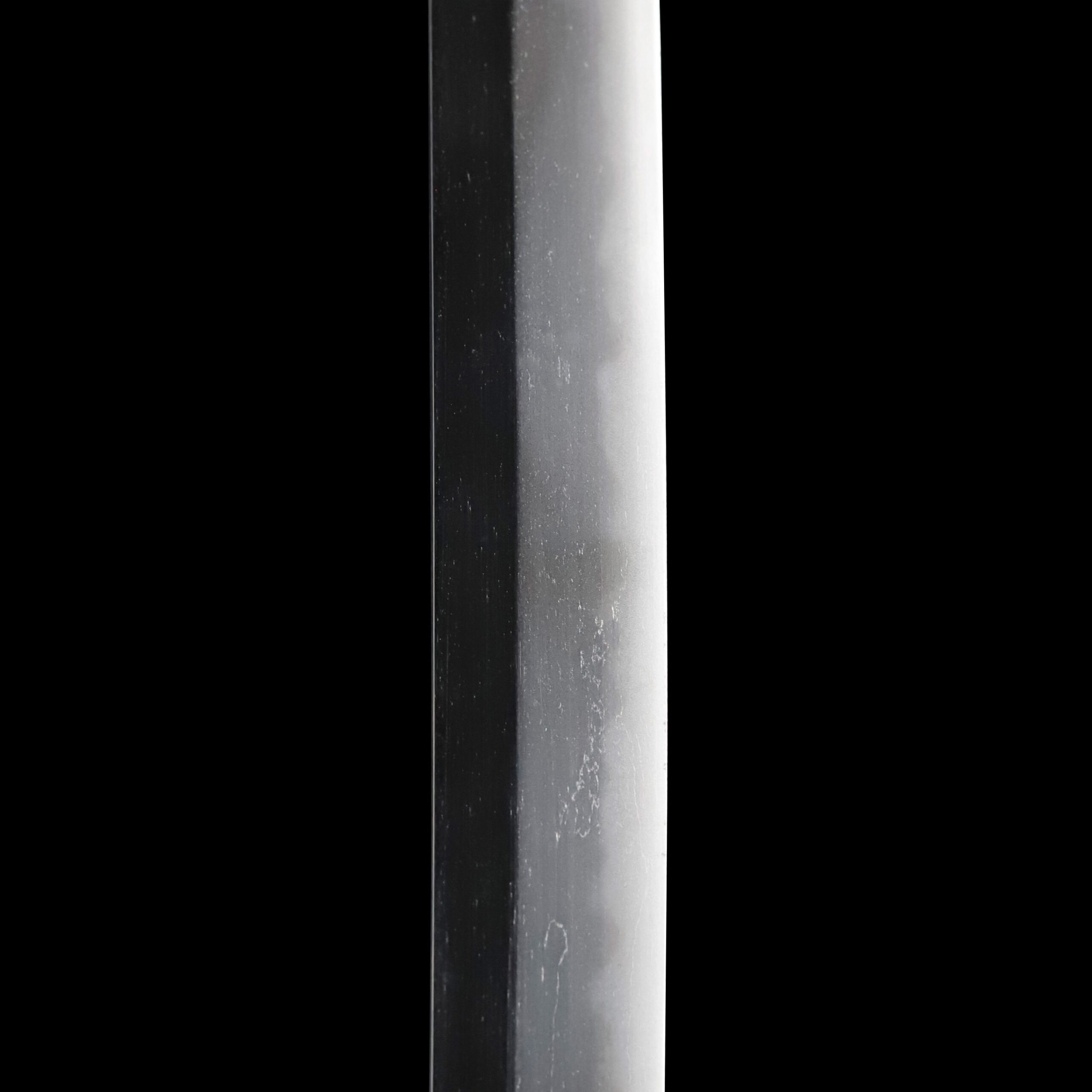
Nakago:Nakago is the tang of the Japanese sword.
Japanese swordsmiths left the black rust on the tang because it prevents red rust while the tang is in its handle. And the discoloration of the tang was created over time, and it is a great indicator for a Japanese sword specialist to estimate when the sword was forged.

Koshirae: Koshirae is the mounting of the Japanese sword. There are several parts that consist of Koshirae such as Saya(Scabbard), Tsuka(Handle), Tsuba(Handguard).
This Tachi Koshirae (太刀拵) has a certificate appraised by NBTHK. We hope you will enjoy the beauty of this Koshirae with the blade. The common motif of this Koshirae’s sword mountings is the Kiri (桐, paulownia). Especially here, the Gosan-no Kiri Mon (五三の桐紋), the popular Kiri design is incorporated. The Kiri pattern is generally composed of three standing straight inflorescences and three leaves. The number of blooming flowers at each inflorescence means the ranks of this design. The imperial family and national leaders of the time once used this plant pattern. Today, this plant pattern is used as the crest of the Japanese Government. And it is permitted to use by ordinary households and is appreciated as their family crests. According to a tradition, the Houou (鳳凰, Fenghuang, a kind of sacred beast) rests its wings at the paulownia tree; therefore, it has come to be regarded as a sacred plant.
We estimate this pattern is designed here as a family crest. As mentioned above, this was a noble design that was once allowed for limited use by people of high social status. Based on this history, we could infer the possibility that a person with some degree of official rank had ordered this Koshirae.
The surface of each sword mounting and metal fittings were finished with the Nanako-Ji (魚子地) technique. By hitting with the Nanako-Ji Tagane (魚子地鏨, chisel used for this technique), delicate fish egg-shaped protrusions are made on the surface of the metal. This process is often seen and is one of the elements that add gorgeousness to the appearance of metalworks.

Fuchi-Kashira:A pair of matching sword fittings that cover the upper and bottom parts of its sword hilt.
In a Tachi Koshirae, these sword mountings are called the Kabutogane (冑金/兜金) and the Fuchi Kanamono (縁金物). The Kabutogane is a metal fitting attached to a handle’s end. And the Fuchi Kanamono is also a metal fitting attached to the handle, but on the opposite side of Kabutogane.
In addition, a Sarute/Sarude (猿手) is attached to this Kabutogane. Even on this such a small part, the Gosan-no Kiri pattern is designed. The user of a sword passed the Udenukio (腕貫緒, a cord wrapped around the wrist to prevent a sword from falling out of the hand, mainly used when riding a horse) through this ring.

Tsuka and Menuki:Tsuka is the handle of the Japanese sword and Menuki is its decoration.
Three family crests are arranged side by side. While we cannot see its entire shape because of the Tsukamaki thread, the Kiri crest is used here, the same as other metal fittings. We could also feel the consistent commitment of the client here.
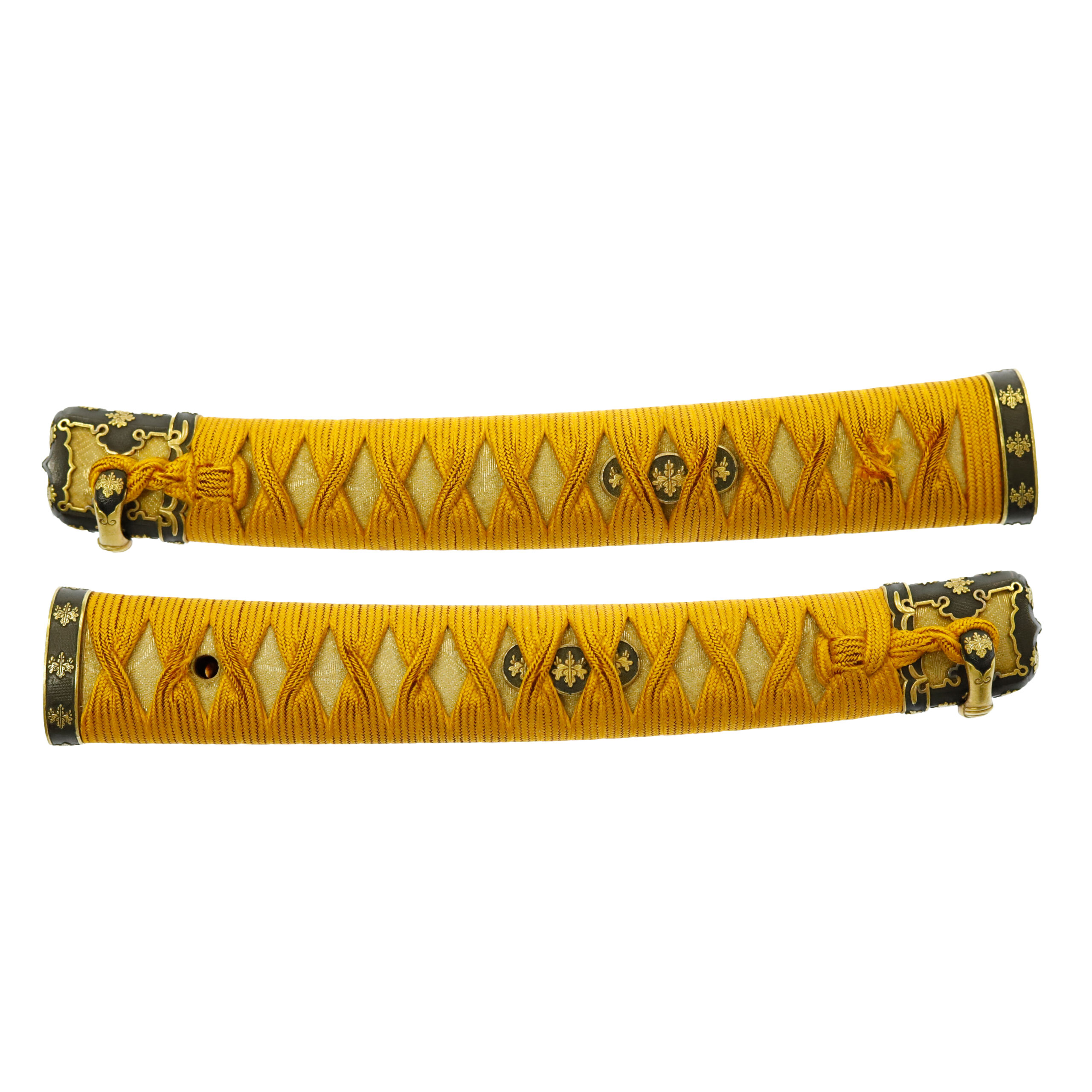
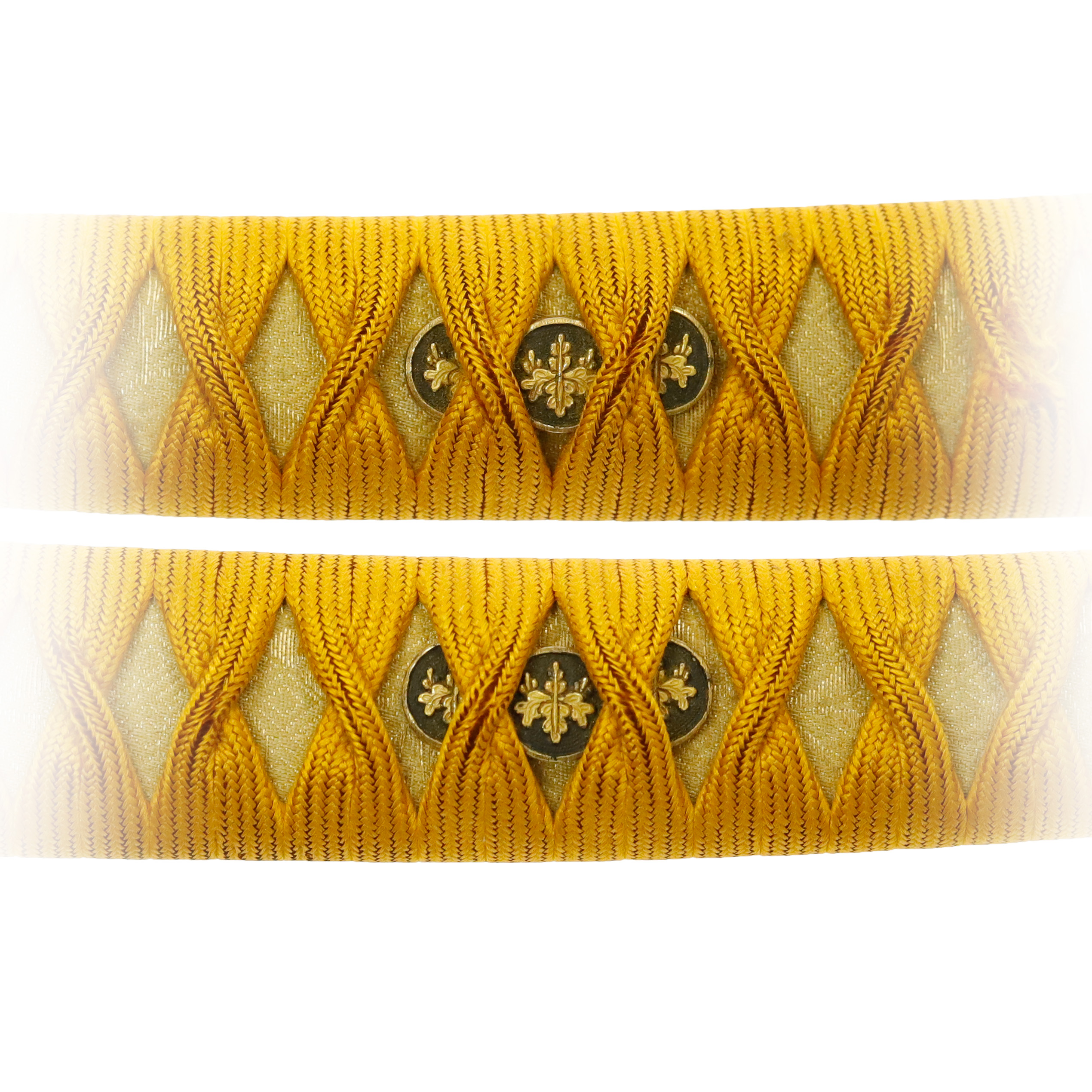
Tsuba and Habaki:Tsuba is the handguard for the Japanese Sword and Habaki is the equipment to make the blade not touch its scabbard inside. It prevents the blade from getting rusty and chipped.
This Tsuba’s shape is categorized as the Aoi (葵) Tsuba, and this type of Tsuba is often seen in Tachi Koshiraes. If you focus on the four corners, you will find a heart-mark hole at each corner. On this Tsuba, you could find eight heart marks in total on each side. This heart mark-shaped design is the Inome (猪の目, boar’s eyes) pattern. It has been used since ancient times. Some people believed the Inome pattern would bring good luck and protect people from evil spirits or fire.
The Gosan-no Kiri Mons are arranged evenly and create a symmetrical design. The Mimi (耳, edge) part is framed with a thick golden plate, and it makes a brilliant appearance of this Tsuba. As with other metal fittings, the harmony of metal black and gold colors gives an elegant impression.

Saya: Saya is the scabbard for the Japanese sword.
You could find the same Gosan-no Kiri Mon on this scabbard. The Seme Kanamono (責金物, a metal fitting attached to the middle of the scabbard to protect the scabbard), the Ishiduki Kanamono (石突金物, a metal fitting attached to the end of the scabbard), these metal parts are also decorated with this plant design. The Taikogane (太鼓金) is a circle-shaped metal fitting attached to the middle of the Taikogawa (太鼓革). The Taikogawa is made from leather and has a role in fixing the Tachio (太刀緒, Sageo for the Tachi Koshirae). This Taikogane also has the same crest design.
The Nashiji Nuri (梨子地塗) technique decorates this scabbard. It is a kind of Makie (蒔絵) methode. This surface treatment method creates a rough texture by creating fine unevenness on the surface of the metal. They also come in varying degrees of gloss, including glossy, semi-gloss, and matte. According to a theory, it was invented in the Kamakura (鎌倉) period (1185-1333), and in the Edo period, various techniques were devised to color the products.
About the design, the Tachi Omodaka Mon (立沢瀉紋) is painted on this scabbard. It is a type of Omodaka (沢瀉) pattern, and the Omodaka is a wetland plant. Its name was compared to another ward Omodaka (面高), which means save face/ keep honor. Also, as its leaf looks similar to an arrowhead (the arrow was once the primary weapon for Samurai warriors), this plant was called the Kachi-Gusa (勝ち草, winning leaf). Based on these things, the Omodaka motif was appreciated among Samurai, and they used it for their family crests.

Authentication Paper:NTHK Kanteisho Certificate for the blade
NTHK, also known as NPO Nihon Touken Hozon Kai, is the oldest organization for sword authentication of Japanese swords in modern times. It was established in 1889 during the post-Samurai era. They authenticated the blade on July 26th in the 5th year of Reiwa (2023). The purchaser will receive this original certificate as well. We can also translate what is written into English and make a PDF file for your record if you request.
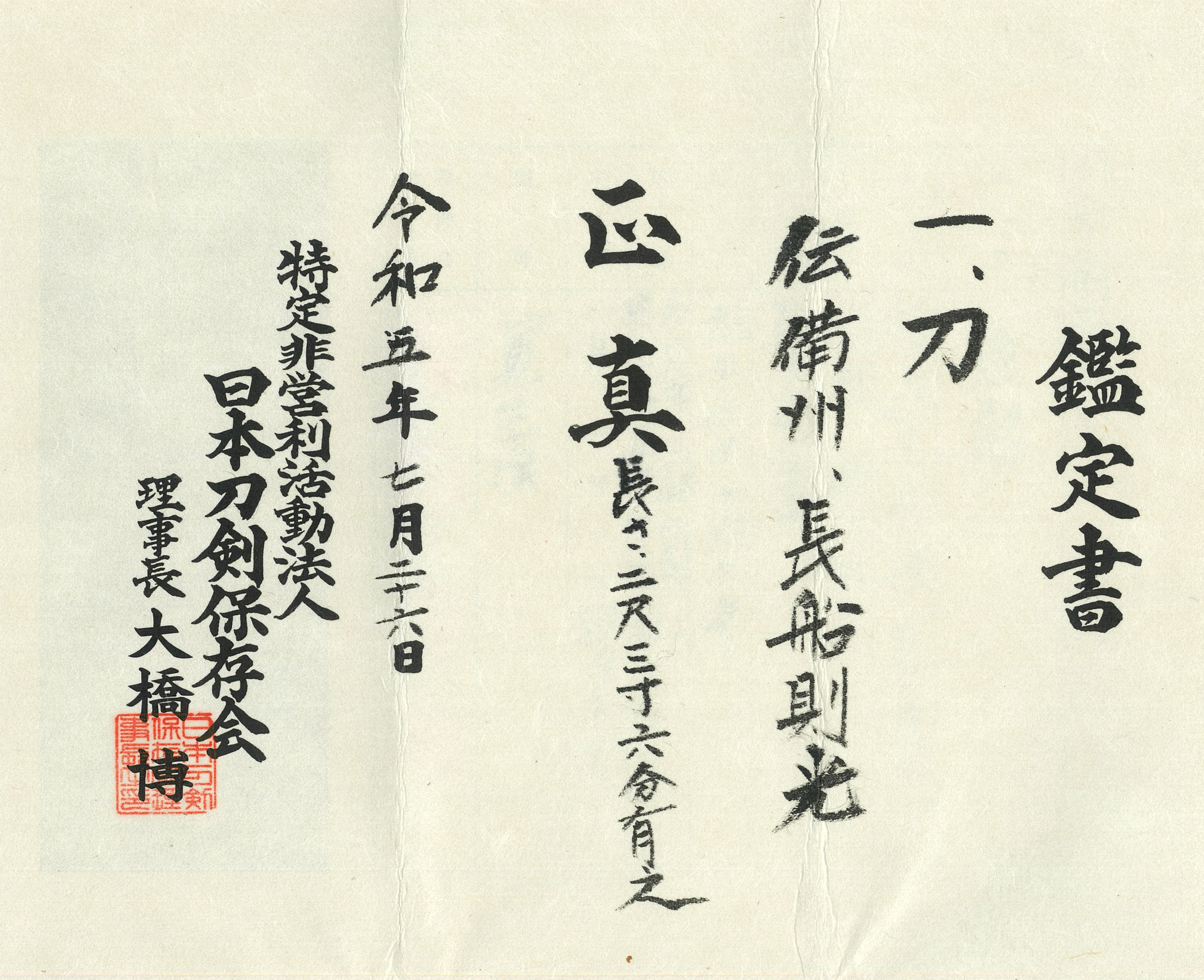

Authentication Paper:NBTHK Hozon Certificate for the Koshirae (No. 402081)
NBTHK, also known as Nihon Bijutsu Touken Hozon Kyokai (the Society for the Preservation of the Japan Art Sword), is one of the oldest Japanese sword appraising organizations in modern-day Japan. They authenticated the Koshirae in December in the 14th year of Reiwa (2022). They appraised it as Hozon Tosogu, the sword mounting worth preserving for Japanese society. We are expecting to receive its certificate by the end of May. The purchaser will receive this original certificate as well. We can also translate what is written into English and make a PDF file for your record if you request.
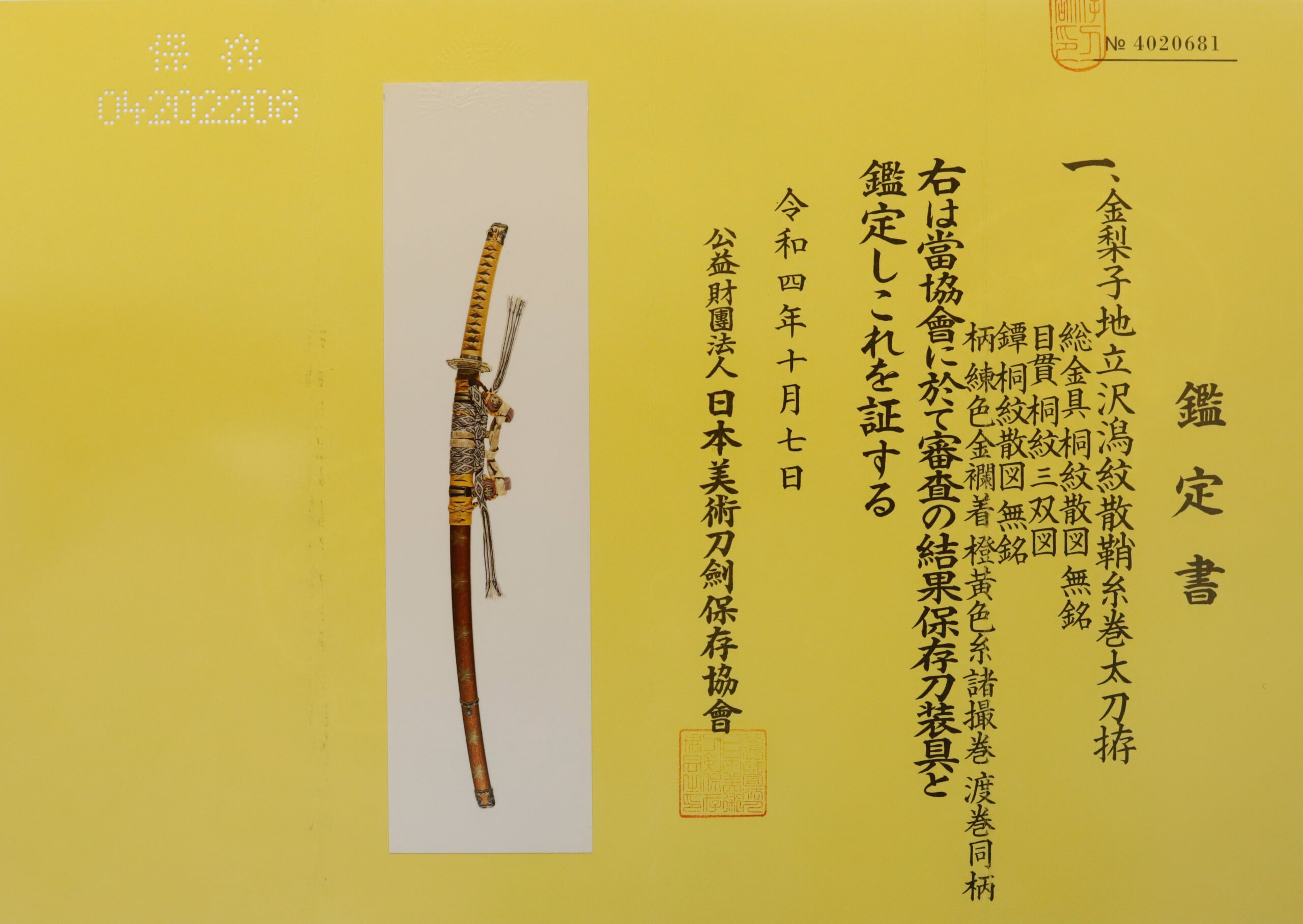
Registration Number : Tokyo 326182
The Board of Education in Tokyo prefecture issued a registration paper for this sword . It is called Jyu Token Rui Torokusho(銃刀剣類登録証). Bunkacho(The Agency for Cultural Affairs) acknowledges a Japanese sword with this paper as a work of art.
The sword needs to be traditionally hand-forged and made of Tamahagane carbon steel to be registered in the system. With this paper, its owner in Japan can legally own an authentic Japanese sword. Based on this registration number, we will apply for its export permit.
This paper will need to be returned to the board of education when the sword is being shipped abroad, but you can receive a copy of it. An English translation of this registration paper is available on request.
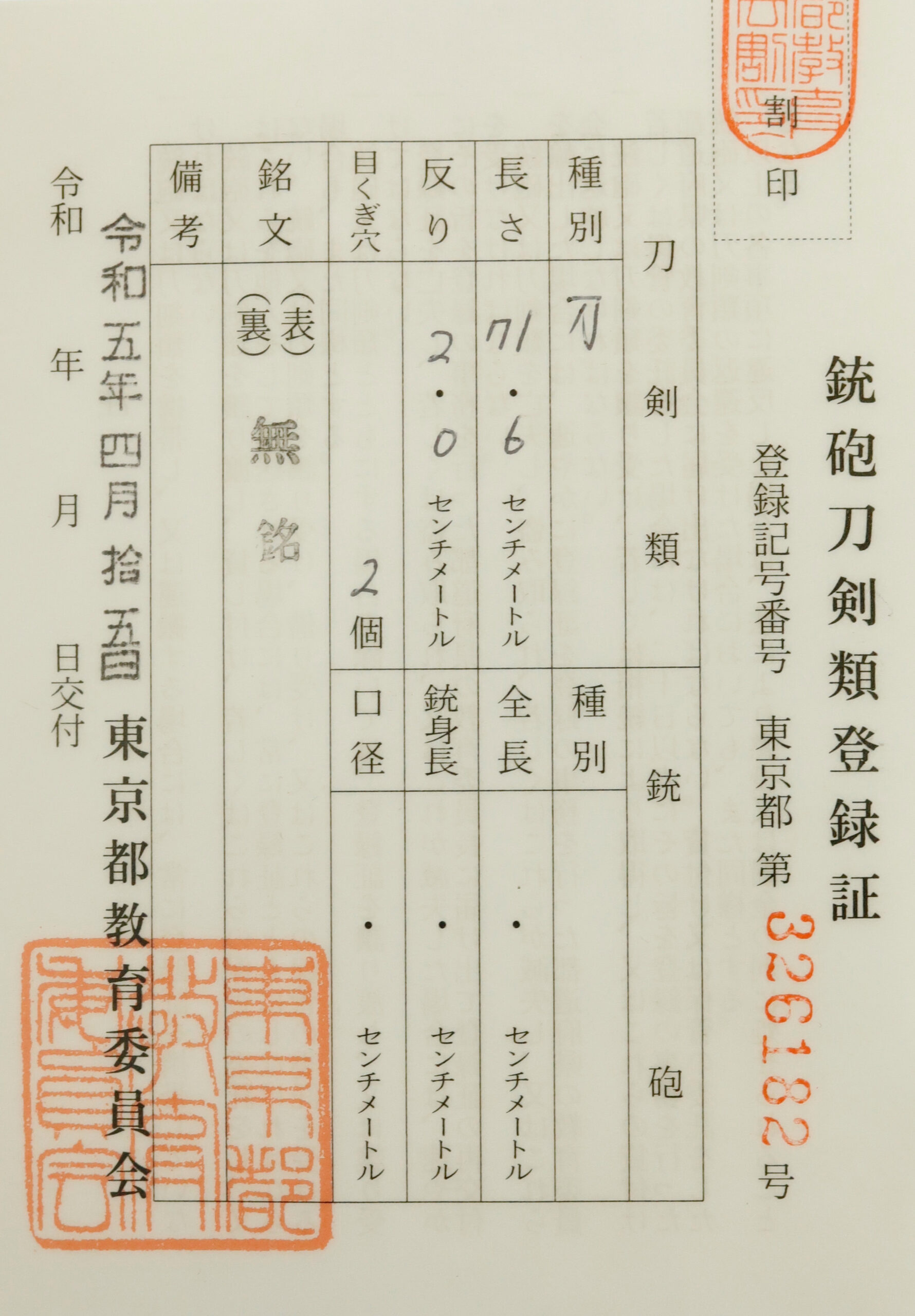
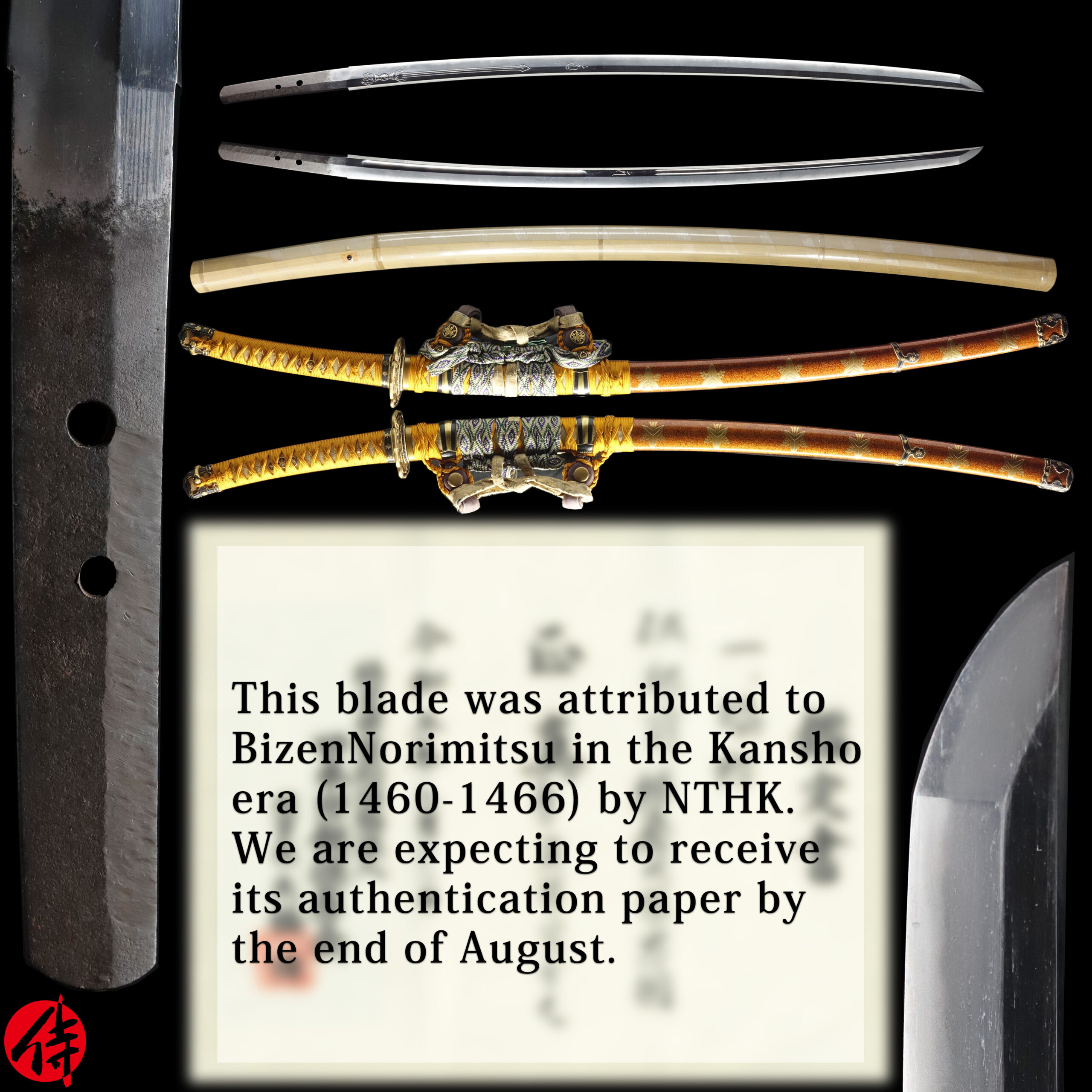
—————————————————————–
【About us】
Samurai Museum is located in Tokyo, Japan, exhibiting antique artifacts related to the Samurai history. Samurai Museum Shop is the place for those who are interested in Japanese culture and craftsmanship. We deal with antique Samurai swords/armor, traditional crafts made in Japan and so on.
【Japanese Sword& Export Process】
The Japanese swords we deal with are hand-forged edged swords made in Japan. It was made from the traditional carbon steel called TAMAHAGANE(玉鋼). Samurai Museum is familiar with the proper legal procedure for an antique/ authentic Japanese sword to be exported from Japan. We have sent more than 500 Japanese swords for the past three years (~2023) to amazing owners who appreciate its historical value.
Each Japanese sword is registered under the Agency for Cultural Affairs and the Board of Education in Japan. They issue a registration paper for each Japanese sword for its owner in Japan to legally possess it. The Japanese sword with its registration paper means it was traditionally hand-forged in Japan.
To legally export the sword from Japan to other countries, we will have to apply for its permit to the Agency for Cultural Affairs(Bunkacho) and return the original registration paper to the Board of Education. It normally takes around 2-4 weeks to receive this permit after submitting required documents. And we would like you to expect at least 1-1.5 months for your order to arrive at your given address after you ordered. For more detailed info, please click here.
It is allowed for residents in Japan to own authentic Japanese swords without a special license as long as they come with registration papers. Please feel free to contact us if you are a resident of Japan, whether temporarily or permanently. We will also assist you when you leave Japan and need to obtain the export permit.
【Payment Method】
We accept payment through Stripe (Credit card), PayPal, Apple Pay or ChromePay, all of which are secure payment methods. Also, you don’t need to make an account on Stripe for the checkout. If you prefer other payment method, please contact us. After confirming your payment, we will apply for an export permit. You may either pay in JPY, USD, AUD, CAD,EUR CHF or GBP. The price is set in Japanese Yen. Prices in other currencies are automatically calculated based on the latest exchange rate.

* If the amount is above 1 million JPY, Stripe or wire transfer will be the only options for payment.
【Shipping】
We have shipped authentic Japanese swords to the USA, UK, Canada, Mexico, Germany, France, Hong Kong and Australia. If you don’t live in these countries and like to order, please contact us first before making a purchase. We offer Free International Shipping as long as we can send antique Japanese swords by EMS.
We normally ship by EMS(Express Mail Service) provided by Japan Post. We will send you a tracking number for your order as soon as we hand it to the post office. We will put 100 % insurance on the shipping document without any extra charge. Based on the total amount, there might be a duty tax or other fee for you to pay, depending on the countries. We use package cushioning to protect the item and put it in a PVC pipe, which is one of the most secure packages because of its durability.
It will normally takes 5-14 days for the item to arrive at your given address after we dispatch it. Time of delivery is estimated as accurately as possible by the carrier but does not take into account any delays beyond our control such as by inclement weather, post office holiday seasons.
* If you live in Australia and like to purchase an authentic Japanese sword, please click here to know the detail.
*Please keep in mind that due to the spread of COVID-19, there might be delays in shipping. If you like to know the detail about shipping, please feel free to ask us.

【Review】
Here is one of the reviews we received from a customer who purchased an authentic Japanese sword from us. For more reviews, please click here.
“My experience overall with the whole process was wonderful. I had many questions about the history and process to purchase these treasures. All my questions were answered very timely and complete. The staff is very knowledgeable and very well versed if any questions do arise.”
【How to make sure the condition】
Please keep in mind that what you are going to purchase is an antique item. We uploaded high resolution photos for you to check its condition thoroughly. If you like to see more photos with different angles, please feel free to contact us. We will be happy to send them to you so that you can make informed decision. It is essential for us to know that you are happy with your choice of a sword. and we are prepared to use the best of our ability to serve you.
【How To Contact Us】
Please contact us through email, Facebook Messenger or Live Chat if you have any questions. You can find each icon on the right side of the website. Please click one of them to reach us. We will reply to you within 1-2 business days.
【The Art of Nihonto (Japanese Sword)】
Samurai’s history is a profound, eloquent legacy of ancient Japanese warriors in which millions of people worldwide are being fascinated. If you like to find out the art of Nihonto, please click here.
【A Guide to Japanese Sword Maintenance】
After acquiring an genuine Japanese sword, it is also important to know how to take good care of it. Here is the special video for you. Mr. Paul Martin, Japanese sword expert, shows you how to give proper maintenance to your sword. By mastering how to clean the Japanese sword, its aesthetic beauty will last forever.
When you purchase a Japanese sword from us, you can get a Free Japanese sword maintenance kit. It comes with four tools(Choji Oil, Uchiko Whetstone Powder, Peg remover, Oil Applicator). By watching the video instruction above , you can enjoy learning how to maintain your Japanese sword while appreciating it. If you have any difficulty assembling the sword or cleaning the blade, you can feel free to contact us.


MORE ANTIQUE JAPANESE SWORD FOR SALE
SWORDS WITHOUT CERTIFICATES FOR SALE
LEARN JAPANESE SWORD TERMINOLOGY
Thank you for reading all the information on the page. If you have any difficulty choosing the right Japanese sword for you, we will be more than happy to help you find the one that speaks to you the most. Please feel free to contact us.
